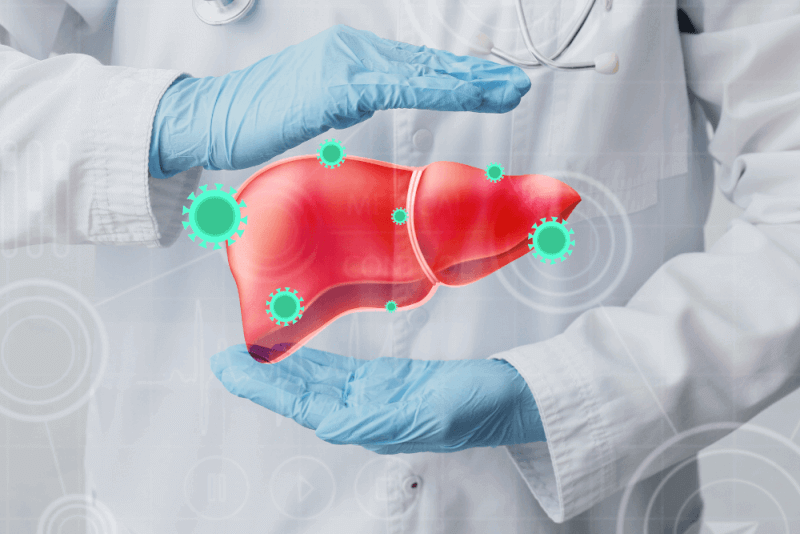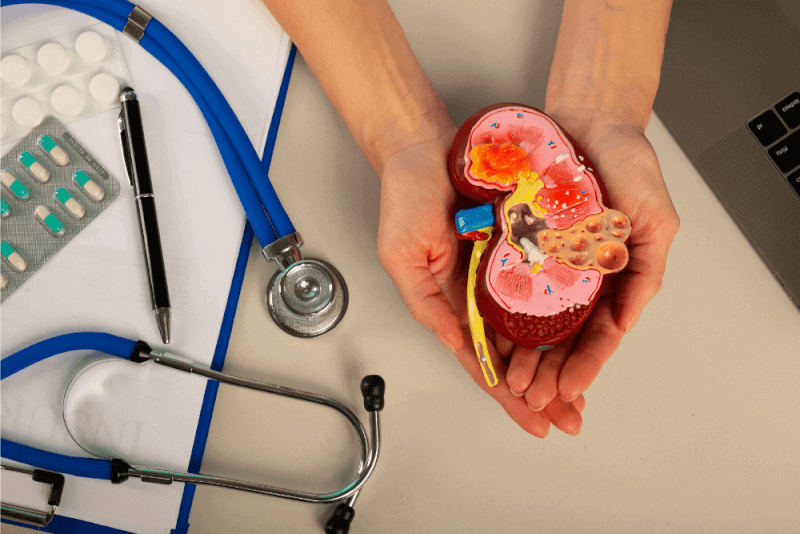Malignant tumors that occur in the liver, the largest organ of the body, are called liver cancer. The vital functions of the liver include the removal of waste from the body, healing of wounds and the absorption of nutrients. Another function of the liver, located on the right side of the abdomen, is the production of bile.
The bile produced by the liver is necessary for both mechanical digestion and the absorption of vitamins and minerals. It also helps to store excess sugar in the blood. Thanks to the storage of sugar in the liver, it slowly releases sugar into the blood during hunger. The liver is also involved in the elimination of medicines and toxins that accumulate in the body.
Cancer that develops in the liver tissue damages the tissues and prevents the liver from fulfilling all these tasks. Cancerization of tissues in the liver can take different forms. The most common of these is hepatocellular carcinoma. This type of cancer is caused by the metamorphosis of hepatocyte cells of hepatocellular carcinoma, one of the main cells of the liver. There are also rarer types of liver cancer such as hepatoblastoma and intrahepatic cholangiocarcinoma.
Liver cancer diagnosis
Different methods are used in the diagnosis of liver cancer. The most common of these are problems detected with liver enzymes and blood tests. In addition, imaging methods such as ultrasound, MRI and CT are also used.
In addition to these imaging methods and blood tests, a biopsy, which can be defined as taking a sample from the problematic area with a thin needle, is extremely important in terms of finalizing the diagnosis. This tissue sample is examined under a microscope in the laboratory. However, the biopsy procedure can cause bruising and infection.
Symptoms of liver cancer
There are many symptoms of liver cancer. In addition, if there is any problem in the gallbladder, there are changes in the symptoms. Symptoms of liver cancer include the following:
- Jaundice
- Pronounced abdominal pain on the right side of the abdomen
- Pain in the right shoulder
- Feeling of a lump in the upper left abdomen
- Non-specific weight loss
- Fatigue
- Gallbladder obstruction
- Anemia
- Bleeding
- Nausea
- Vomiting
- White or lime-colored stools
Causes of liver cancer
The liver is seen as the body’s factory. It therefore affects all systems. However, in the early stages, liver cancer is very difficult to diagnose because the symptoms are not obvious. Especially at risk are people with hepatitis and cirrhosis. In addition, factors that can cause liver cancer include the following:
- Nitrites
- Hydrocarbons
- Solvents
- Glycogen storage disease
- Wilson’s disease
- Hemochromatosis
- Genetic congenital metabolic diseases
- Aflatoxin
- Hepatitis D virus infections
- Excessive alcohol consumption
- Cigarette smoking
Common risk factors for liver cancer
The exact cause of liver cancer is unknown. However, it is known that some groups are more at risk and therefore have an increased incidence of liver cancer. On the other hand, liver cancer can also occur in people without risk factors.
Race and gender
Liver cancer is more common in Pacific Islanders and Asians. Because hepatitis is more common in this region. In addition, liver cancer is less common in Caucasians. In addition, liver cancer is more common in men than in women.
Chronic Hepatitis B
One of the key factors for the development of liver cancer is hepatitis B. People with hepatitis B are 100 times more likely to develop liver cancer. Especially cirrhosis due to hepatitis B increases the risk.
Hepatitis C infection
Hepatitis C infection is the most common cause of liver cancer in Europe, the United States and Japan.
Non-alcoholic fatty liver disease
The cause of non-alcoholic fatty liver disease, an autoimmune disease, is thought to be genetic. This disease, which causes fat to accumulate in the liver, increases the risk of liver cancer.
Immunosuppression
Suppression of immunity for any reason increases the risk of liver cancer as well as other types of cancer. For this reason, liver cancer is 2 times more likely to occur in people who have had a liver transplant.
Lupus
Although the cause is unknown, liver cancer is more common in people with lupus.
Diabetes
Diabetics are 2 to 3 times more likely to develop liver cancer. On the other hand, drugs with the active ingredient metformin used in diabetes treatment are known to reduce the risk of liver cancer.
Occupational risk
One of the causes of liver cancer is chemical exposure. Occupational groups in direct contact with carcinogenic chemicals are more likely to develop liver cancer.
Sclerosing Cholangitis
Associated with inflammatory bowel diseases, sclerosing cholangitis is a liver disease. Because it causes inflammation and scarring of the bile, it causes bile to return to the liver.
Aflatoxin exposure
Toxins caused by fungi in foods such as peanuts or wheat. These toxins cause damage to the p53 gene in liver cells. This gene is a tumor suppressor gene that helps repair damaged DNA and inhibits the growth of harmful cells.
Liver cancer treatment
Different methods are used in the treatment of liver cancer. For this reason, many different features are taken into consideration when planning the treatment method to be applied to patients with liver cancer. Among these, factors such as the size, location and number of tumors are at the forefront. Factors such as the extent to which the cancerous tissues affect the function of the liver, whether the cancer has spread, and other factors are also taken into account. However, when it comes to liver cancer, surgical treatment options come to the forefront.
Liver cancer surgery
Liver cancer surgery is called partial hepatectomy. In this procedure, the part of the liver affected by the tumor is removed. It is possible for the liver tissue to repair itself. However, this operation is suitable for liver cancer diagnosed at an early stage.
Liver transplantation
It is one of the most appropriate treatment options for cases where liver cancer has not metastasized. Liver transplant patients need to take immunosuppressive drugs for the rest of their lives to prevent tissue rejection.
Ablation
Ablation, another method used in liver cancer, is the application of heating or cooling to cancerous tissues using ethanol injections. These heat changes cause destruction of cancerous tissues. Since the procedure is performed under local anesthesia, patients do not feel any pain or soreness.
High energy radiofrequency
Radiotherapy for the elimination of cancer cells is divided into two categories: external and internal. In external radiotherapy, the cancerous area is bombarded with radiation from outside. In internal radiotherapy, a low radioactive material is left in or near the cancerous tissue.
Chemotherapy
In liver cancer, as in other types of cancer, strong chemical drugs are used to eliminate tumor cells.
Other treatment methods
In addition to these treatment methods, there are also treatment methods to prevent the growth of cancerous tissue. Among these, there are especially targeted treatment applications that separate cancerous cells from healthy cells and affect only cancerous cells.
In addition to these, immunotherapy interventions in addition to other treatments increase the chances of treatment success.
Types of liver cancer
Liver cancer is basically divided into two groups. These groups include primary and secondary liver cancers.
Secondary
Secondary liver cancer is the formation of cancerous tissues in the liver due to metastasis, which occurs in another organ or tissue.
Primer
In primary liver cancer, cancerous cells first arise in the liver tissue itself. In later stages, it can metastasize to other organs.
Stages of liver cancer
In liver cancer, as in other types of cancer, staging is a way of identifying the stage of the cancer or whether it has metastasized. For this reason, staging liver cancer is extremely important for planning treatment and increasing the chances of success.
Phase 1
The first stage of liver cancer is divided into A and B. In stage 1A, the size of the malignant tumor in the liver is 2 cm or less. It also means that the tumor cells have not spread into the blood vessels.
In stage 1B liver cancer, the tumor cells do not spread to the blood vessels, but the tumor size is larger than 2 cm. In the TNM staging system, the first stage of liver cancer is T1a or T1b with N0 and M0.
Phase 2
In the second stage of liver cancer, there is a single tumor larger than 2 cm or multiple tumors between 5 cm and 2 cm that turn into blood vessels. In the second stage of liver cancer, metastases are not yet seen. In the TNM staging system, it is T2, N0 and M0.
Phase 3
When liver cancer is in the third stage, it means that it has metastasized. 3. Stage A, B and C liver cancer is divided into three categories. The purpose of this classification is to identify which organs the tumors involve.
In stage 3A, tumors are smaller than 5 cm and spread to 4 to 9 lymph nodes. At this stage, tumors can be larger than 5 cm in size. In this case, it spreads to between 1 and 9 lymph nodes.
In stage 3B, the size of the tumor may vary. However, the differential diagnosis of this stage is tumors that have invaded the chest wall or skin. They also have swollen or inflamed ulcers. In addition to these features of stage 3B, cancer tumors can also spread to the lymph nodes.
In stage 3c, the size of the tumors can be different again. What is important in staging is the spread to 10 or more lymph nodes. It spreads especially to lymph nodes in the armpit, collarbone and near the breastbone.
Phase 4
In stage 4 liver cancer, the disease has spread to other organs or lymph nodes. 4. The phase is also divided into two groups. The first of these groups is 4a. In 4a liver cancer, tumor cells have spread to the lymph nodes. However, distant organs do not yet show tumors.
In 4b liver cancer, the tumor has both spread to the lymph nodes and metastasized to distant organs.
Stage 4 symptoms
Liver cancer is one of the insidious types of cancer. For this reason, patients may not show any symptoms in the early stages of the disease. But 4. In this stage, patients develop many symptoms. These symptoms include the following:
- Abdominal pain
- Abdominal swelling
- Acid accumulation in the abdomen
- Loss of appetite
- Early satiety
- Generalized itching
- Jaundice
- Liver enlargement
- Nausea
- Vomiting
- Pain in the right shoulder
- Spleen enlargement
- Involuntary weight loss
- Swelling in the legs
In some patients, the tumor in the liver starts to produce hormones. Other symptoms seen in patients in this condition are as follows:
- Breast enlargement in men
- Testicular shrinkage
- Production of high levels of red blood cells
- High cholesterol
- Confusion
- Nausea
- Constipation
- Increased amount of calcium in the body causing muscle problems
- Hypoglycemia













